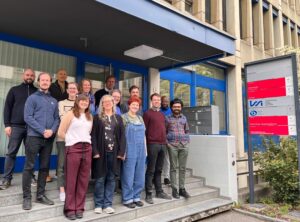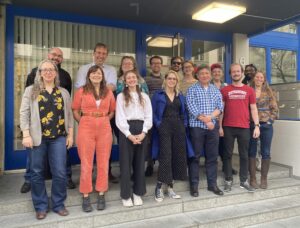ISSI Participants in April 2024

- Karen Masters (Haverford College)
- Sandor Kruk (ESA)
- Brooke Simmons (Lancaster)
- Chris Lintott (Oxford)
- David O’Ryan (ESA)
- Hayley Roberts (Minnesota)
- Izzy Garland (Lancaster)
- Jason Shingirai Makechemu (Lancaster)
- Kameswara Mantha (Minnesota)
- Lucy Fortson (Minnesota)
- Mike Walmsley (Toronto)
- Tobias Geron (Toronto)
- Willam Keel (Alabama; Remote)
- Becky Smethurst (Oxford)
- Hugh Dickinson (OU)
ISSI Participants in March 2025

- Karen Masters (Haverford College)
- Sandor Kruk (ESA)
- Brooke Simmons (Lancaster)
- Chris Lintott (Oxford)
- David O’Ryan (ESA)
- Hayley Roberts (Minnesota)
- Izzy Garland (Masaryk University, Czech)
- Jason Shingirai Makechemu (Lancaster)
- Kameswara Mantha (Minnesota; Remote)
- Lucy Fortson (Minnesota)
- Mike Walmsley (Toronto)
- Tobias Geron (Toronto)
- Becky Smethurst (Oxford)
- Jurgen Popp (OU)
- Dhanesh Krisharao (Colorado College)
- Sophie Jewell (Oxford)
ISSI Participants in Proposal
Team leader:
Karen Masters is the Principal Investigator of Galaxy Zoo (formerly the Project Scientist, 2010-2021) and an expert in galaxy morphology from crowd-sourcing, including those based on HST images. She has also been heavily involved in large scale data releases in projects as the Spokesperson for SDSS-IV. She will lead the project and the team meeting, and the analysis of barred galaxies.
Team members:
Brooke Simmons is the Galaxy Zoo Deputy PI; an expert on galaxy morphology from crowdsourcing, and lead of some of the Galaxy Zoo HST work. Brooke has done some early work on JWST images and will lead the design of the classification workflow, of the crowd-sourcing interface (example images, tutorial, etc.) and the assembly of source catalogs.
Chris Lintott is the PI of the Zooniverse, and founder of Galaxy Zoo; an expert in galaxy morphology and citizen science online. Chris will lead the communication with the volunteers, the advertisement of the project, and will be the link to Zooniverse.
Bill Keel is an expert in HST observations of nearby galaxies (PI of Zoo Gems) as well as galaxy morphology and identification of rare systems from crowdsourcing. Bill will be the point of contact with the moderators and the active volunteers on the platform, following up on rare and interesting objects discovered in the project.
Mike Walmsley is an expert in combining machine learning and citizen science to measure galaxy morphology, and the Technical Lead for the Galaxy Zoo project. Mike will lead the analysis of the volunteer classifications, optimize the classification process by making use of a machine learning-based classifier developed for Galaxy Zoo, Zoobot, and the creation of the catalog.
Rebecca Smethurst is an expert in galaxy morphology and the Deputy Project Scientist for Galaxy Zoo. In addition Dr Smethurst is also an expert in communicating complex astrophysical ideas to members of the public, in particular results from JWST, on social media. Rebecca will lead the communication and scientific analysis of the global morphological types.
Sandor Kruk is Project Scientist of Galaxy Zoo, an expert in galaxy morphology and in data archives from the ESA and NASA space missions. Sandor will lead the data access and data gathering from the ESA JWST and MAST archives, as well as lead the redshift debiasing of the classifications.
Kameswara Mantha is Data Scientist and expert in the identification of outliers in large samples with machine learning. Kameswara will lead the identification of rare and interesting objects in JWST data using crowdsourcing and machine learning.
David O’Ryan recently finished his PhD working on creating large catalogs of classified objects and an expert in galaxy mergers. David will work on the postage stamp creation of galaxies from JWST images and the scientific analysis of merging galaxies.
Izzy Garland is a PhD student working on the connection between barred galaxies, merger-free galaxies and AGN. Izzy will lead the analysis of the classifications of bulgeless galaxies and AGN.
Dhanesh Krishnarao is an expert in the use of morphology and resolved spectroscopy to understand galaxy morphology. He also works on a project to bring Galaxy Zoo into elementary and middle school classrooms in the USA via the use of podcasting. He will work on ancillary data collection for the JWST catalogs, and US-based education outreach.
Lucy Fortson is a founding member of Zooniverse and an expert in crowdsourcing. Lucy will lead the advertisement of the project in the US, the recruitment of volunteers and the optimisation of the classifications.

